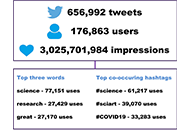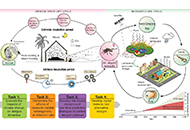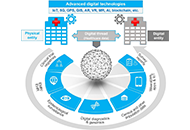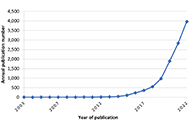Envisioning urban environments resilient to vector-borne diseases: a protocol to study dengue in Vietnam
Transmitted primarily by
Aedes aegypti (
Ae. aegypti) and
Aedes albopictus (
Ae. albopictus), arboviral diseases pose a major global public health threat. Dengue, chikungunya, and Zika are increasingl
[...] Read more.
Transmitted primarily by Aedes aegypti (Ae. aegypti) and Aedes albopictus (Ae. albopictus), arboviral diseases pose a major global public health threat. Dengue, chikungunya, and zika are increasingly prevalent in Southeast Asia. Among other arboviruses, dengue and zika are becoming more common in Central and South America. Given human encroachment into previously uninhabited, often deforested areas, to provide new housing in regions of population expansion, conceptualizing built urban environments in a novel way is urgently needed to safeguard against the growing climate change-driven threat of vector-borne diseases. By understanding the spread from a One Health perspective, enhanced control and prevention can be achieved. This is particularly important considering that climate change is likely to significantly impact the persistence of ponded water where mosquitoes breed due to increasing temperature and shifting rainfall patterns with regard to magnitude, duration, frequency, and season. Models can incorporate aquatic mosquito stages and adult spatial dynamics when habitats are heterogeneously available, thereby including dispersal and susceptible-exposed-infected-recovered (SEIR) epidemiology. Coupled with human population distribution (density, locations), atmospheric conditions (air temperature, precipitation), and hydrological conditions (soil moisture distribution, ponding persistence in topographic depressions), modeling has improved predictive ability for infection rates. However, it has not informed interventional approaches from an urban environment perspective which considers the role of ponds/lakes that support green spaces, the density of population that enables rapid spread of disease, and varying micro-habitats for various mosquito stages under climate change. Here, for an example of dengue in Vietnam, a preventive and predictive approach to design resilient urban environments is proposed, which uses data from rapidly expanding metropolitan communities to learn continually. This protocol deploys computational approaches including simulation and machine learning/artificial intelligence, underpinned by surveillance and medical data for validation and adaptive learning. Its application may best inform urban planning in low-middle income countries in tropical zones where arboviral pathogens are prevalent.
Praveen Kumar ... Andrew W. Taylor-Robinson
View:3658
Download:230
Times Cited: 0
Transmitted primarily by Aedes aegypti (Ae. aegypti) and Aedes albopictus (Ae. albopictus), arboviral diseases pose a major global public health threat. Dengue, chikungunya, and zika are increasingly prevalent in Southeast Asia. Among other arboviruses, dengue and zika are becoming more common in Central and South America. Given human encroachment into previously uninhabited, often deforested areas, to provide new housing in regions of population expansion, conceptualizing built urban environments in a novel way is urgently needed to safeguard against the growing climate change-driven threat of vector-borne diseases. By understanding the spread from a One Health perspective, enhanced control and prevention can be achieved. This is particularly important considering that climate change is likely to significantly impact the persistence of ponded water where mosquitoes breed due to increasing temperature and shifting rainfall patterns with regard to magnitude, duration, frequency, and season. Models can incorporate aquatic mosquito stages and adult spatial dynamics when habitats are heterogeneously available, thereby including dispersal and susceptible-exposed-infected-recovered (SEIR) epidemiology. Coupled with human population distribution (density, locations), atmospheric conditions (air temperature, precipitation), and hydrological conditions (soil moisture distribution, ponding persistence in topographic depressions), modeling has improved predictive ability for infection rates. However, it has not informed interventional approaches from an urban environment perspective which considers the role of ponds/lakes that support green spaces, the density of population that enables rapid spread of disease, and varying micro-habitats for various mosquito stages under climate change. Here, for an example of dengue in Vietnam, a preventive and predictive approach to design resilient urban environments is proposed, which uses data from rapidly expanding metropolitan communities to learn continually. This protocol deploys computational approaches including simulation and machine learning/artificial intelligence, underpinned by surveillance and medical data for validation and adaptive learning. Its application may best inform urban planning in low-middle income countries in tropical zones where arboviral pathogens are prevalent.
 Science communication on X (formerly Twitter): A picture is worth a thousand characters?Open AccessPerspectiveX (formerly Twitter), a microblogging social media platform, is being used by scientists and researchers to disseminate their research findings and promote the visibility of their work to the public [...] Read more.Himel Mondal ... Harald WillschkePublished: November 28, 2023 Explor Digit Health Technol. 2023;1:28–34
Science communication on X (formerly Twitter): A picture is worth a thousand characters?Open AccessPerspectiveX (formerly Twitter), a microblogging social media platform, is being used by scientists and researchers to disseminate their research findings and promote the visibility of their work to the public [...] Read more.Himel Mondal ... Harald WillschkePublished: November 28, 2023 Explor Digit Health Technol. 2023;1:28–34 Envisioning urban environments resilient to vector-borne diseases: a protocol to study dengue in VietnamOpen AccessProtocolTransmitted primarily by Aedes aegypti (Ae. aegypti) and Aedes albopictus (Ae. albopictus), arboviral diseases pose a major global public health threat. Dengue, chikungunya, and Zika are increasingl [...] Read more.Praveen Kumar ... Andrew W. Taylor-RobinsonPublished: November 01, 2023 Explor Digit Health Technol. 2023;1:17–27
Envisioning urban environments resilient to vector-borne diseases: a protocol to study dengue in VietnamOpen AccessProtocolTransmitted primarily by Aedes aegypti (Ae. aegypti) and Aedes albopictus (Ae. albopictus), arboviral diseases pose a major global public health threat. Dengue, chikungunya, and Zika are increasingl [...] Read more.Praveen Kumar ... Andrew W. Taylor-RobinsonPublished: November 01, 2023 Explor Digit Health Technol. 2023;1:17–27 Harnessing the untapped potential of digital twin technology in digital public health interventionsOpen AccessLetter to the EditorDigital technologies have garnered more attention in this epoch of public health emergencies like coronavirus disease 2019 (COVID-19) and monkeypox (mpox). Digital twin (DT) is the virtual cyberneti [...] Read more.Salman Khan ... ArunSundar MohanaSundaramPublished: November 01, 2023 Explor Digit Health Technol. 2023;1:11–16
Harnessing the untapped potential of digital twin technology in digital public health interventionsOpen AccessLetter to the EditorDigital technologies have garnered more attention in this epoch of public health emergencies like coronavirus disease 2019 (COVID-19) and monkeypox (mpox). Digital twin (DT) is the virtual cyberneti [...] Read more.Salman Khan ... ArunSundar MohanaSundaramPublished: November 01, 2023 Explor Digit Health Technol. 2023;1:11–16 Turbulence at Twitter with leadership change: implications for health research and science communicationOpen AccessPerspectiveTwitter has been an invaluable social media platform for scientists to share research and host discourse among academics and the public. The change of ownership at Twitter has changed how scientists [...] Read more.Ronan Lordan, Hari Prasad DevkotaPublished: November 01, 2023 Explor Digit Health Technol. 2023;1:4–10
Turbulence at Twitter with leadership change: implications for health research and science communicationOpen AccessPerspectiveTwitter has been an invaluable social media platform for scientists to share research and host discourse among academics and the public. The change of ownership at Twitter has changed how scientists [...] Read more.Ronan Lordan, Hari Prasad DevkotaPublished: November 01, 2023 Explor Digit Health Technol. 2023;1:4–10 Exploration of Digital Health TechnologiesOpen AccessEditorialAtanas G. AtanasovPublished: November 01, 2023 Explor Digit Health Technol. 2023;1:1–3
Exploration of Digital Health TechnologiesOpen AccessEditorialAtanas G. AtanasovPublished: November 01, 2023 Explor Digit Health Technol. 2023;1:1–3